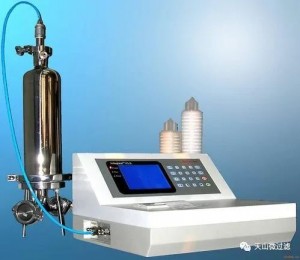A method for the determination of the “integrity” of filtration membrane in the terminal of wine filling line was established and verified in practical production. The “integrity” test method of filter membrane can effectively judge whether the filter membrane is complete, scientifically guide the filling production, and is also an effective method to screen the type of filter membrane and judge the service life of wine filling line.
Wine filling is one of the key links in wine production, which directly affects the stability of bottled wine. At home and abroad, 0.45μm terminal membrane filtration method is often used to filter out bacteria, mold, yeast and other microorganisms in wine microfiltration systems to prevent wine from being infected by microorganisms. Therefore, whether the filter membrane is complete or not has production significance for wine sterilization filtration.
 Most Chinese wine manufacturers use the foldable filter element for terminal sterilization filtration. The membrane material is nylon 66 material, which has good stability and can be recovered by thermal sterilization and forward washing. The pore size of the filter membrane is 0.45μm, which can filter out microorganisms in wine and prevent secondary contamination of wine. Before the method of “integrity” determination of filter membrane was established, the test results of each batch of bottled wine after filling were used to predict whether the filter membrane was damaged. In order to ensure the quality of wine, the service life of folding filter element is very strict, and the replacement period is generally much shorter than the effective service life of filter membrane rod. Because the folding filter element is expensive and the service life is short, it is called “luxury filter”. Because it is impossible to determine whether the folded filter element under replacement is intact, it cannot be used in production, so a large amount of old filter membrane replaced each time has to be stored in the freezer. Therefore, it is of practical significance to establish the detection method of “integrity” of filter membrane and study how to apply the detection method online, which can reduce the cost, improve the filling production efficiency, and screen and determine the suitable filter membrane for wine manufacturers.
Most Chinese wine manufacturers use the foldable filter element for terminal sterilization filtration. The membrane material is nylon 66 material, which has good stability and can be recovered by thermal sterilization and forward washing. The pore size of the filter membrane is 0.45μm, which can filter out microorganisms in wine and prevent secondary contamination of wine. Before the method of “integrity” determination of filter membrane was established, the test results of each batch of bottled wine after filling were used to predict whether the filter membrane was damaged. In order to ensure the quality of wine, the service life of folding filter element is very strict, and the replacement period is generally much shorter than the effective service life of filter membrane rod. Because the folding filter element is expensive and the service life is short, it is called “luxury filter”. Because it is impossible to determine whether the folded filter element under replacement is intact, it cannot be used in production, so a large amount of old filter membrane replaced each time has to be stored in the freezer. Therefore, it is of practical significance to establish the detection method of “integrity” of filter membrane and study how to apply the detection method online, which can reduce the cost, improve the filling production efficiency, and screen and determine the suitable filter membrane for wine manufacturers.
Establishment of “integrity” detection method for terminal filtration membrane
There are many methods to test the “integrity” of the filter membrane, such as bubbling point test, pressure attenuation value test, diffused air flow test and water displacement test, etc. The bubbling point test and pressure attenuation value test are widely used in wine production.
The blister point test, a diagnostic test, is performed by applying pressure to the upstream side of an already wet membrane when the pressure increases
Bubbles are formed when the surface tension of the liquid in the pore size of the filter membrane is overcome. If the observed bubbling point pressure is significantly lower than the bubbling point pressure (given by the membrane manufacturer), the integrity of the membrane has been compromised. The bubbling point method is generally used to test the integrity of a single filter element of 25.4 cm or less.
Pressure attenuation value test, the specific method is to wet the film with pure water before the test, drain the residual water upstream of the filter element, press the air into the upstream side of the wetting film at a pressure lower than the foaming point (generally about 80% of the foaming point), and then close all upstream valves to isolate and maintain pressure. A sensitive pressure sensor is used to detect the pressure in the closed volume upstream of the wetted filter element at a specific time.
Post time: Oct-09-2022


